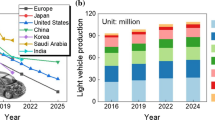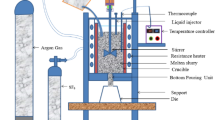Abstract
Aluminum-based ceramic cores have been widely used in the manufacture of aero-engine hollow blades because of their excellent chemical stability, stable high-temperature properties and mechanical properties. In this study, in order to prepare alumina-based ceramic cores with stable strength, high apparent porosity and low sintering shrinkage, ceramic greens with predominantly irregular polyhedral alumina powder particles were successfully prepared using selective laser sintering technique. Subsequently, sol infiltration process was used to improve the mechanical properties of alumina-based ceramics, and the effects of nanoalumina sol and silica sol infiltration on the micromorphology and mechanical properties of ceramic bodies were studied. The results showed that the green bodies contained more holes when the incubation space and printed layer thickness were determined with a scanning speed and laser power of 2300 mm/s and 30 W, respectively. After infiltration of nanosilica sol, the apparent porosity of alumina-based ceramics decreased from 44.7% to 35.3%, and the ultimate compressive strength increased from 32.5 MPa to 78.8 MPa. After three cycles of infiltration, the compressive strength of the samples reached 117.2 MPa and the flexural strength reached 12.6 MPa. These are caused by the reaction of silica nanoparticles with alumina ceramic bodies at 1300 °C to form mullite and α-cristobalite phases.












Similar content being viewed by others
References
Koutayas SQ, Kern M (1999) All-ceramic posts and cores: the state of the art. Quintessence Int. 30(6):383–392
Osorio JD, Toro A, Hernandez-Ortiz JP, Hernandez-Ortiz, (2012) Thermal barrier coatings for gas turbine applications: failure mechanisms and key microstructural features. Dyna Colombia 79(176):149–158. https://doi.org/10.1126/science.1068609
Gao Y, Chen MC, Shi CX (1999) Study on EB-PVD zirconia thermal barrier coatings for gas turbine blade protection. Mater Manuf Process 14(5):691–696. https://doi.org/10.1080/10426919908914862
Li QL, Meng XT, Zhang XC, Liang JJ, Zhang CW, Li JG, Zhou YZ, Sun XF (2022) Enhanced 3D printed Al2O3 core via in-situ mullite. Addit Manuf 55:14. https://doi.org/10.1016/j.addma.2022.102826
Tagmatarchis A, Tripodakis A-P, Filippatos G, Zinelis S, Eliades G (2014) Interfacial characterization of ceramic core materials with veneering porcelain for all-ceramic bi-layered restorative systems. Int J Esthet Dent 9(4):536–50
Sundh A, Sjogren G (2004) A comparison of fracture strength of yttrium-oxide-partially-stabilized zirconia ceramic crowns with varying core thickness. Shap Veneer Ceram 31(7):682–688. https://doi.org/10.1111/j.1365-2842.2004.01284.x
Kim EH, Oh YS, Jung YG (2004) Relationship between network structure and fracture strength of ceramic core in a gel-casting process. Ceram Int 41(3):3396–3399. https://doi.org/10.1016/j.ceramint.2014.10.124
Qin YX, Pan W (2009) Effect of silica sol on the properties of alumina-based ceramic core composites. Mater Sci Eng 508(1–2):71–75. https://doi.org/10.1016/j.ceramint.2019.08.248
Chen X, Liu CY, Zheng WL, Han JQ, Zhang L, Liu CM (2020) High strength silica-based ceramics material for investment casting applications: effects of adding nanosized alumina coatings. Ceram Int 46(1):196–203. https://doi.org/10.1016/j.ceramint.2019.08.248
Kazemi A, Faghihi-Sani MA, Alizadeh HR (2013) Investigation on cristobalite crystallization in silica-based ceramic cores for investment casting. J Eur Ceram Soc 33(15–16):3397–3402. https://doi.org/10.1016/j.jeurceramsoc.2013.06.025
Lu G, Chen YS, Yan QS, Zhan HX, Mao P, Liu D (2021) Investigation of microstructure and properties in short carbon fiber reinforced silica-based ceramic cores via atmosphere sintering. J Eur Ceram Soc 41(14):7339–7347. https://doi.org/10.1016/j.jeurceramsoc.2021.07.015
Zheng W, Wu JM, Chen S, Yu KB, Zhang J, Liu H, Huo YF, Shi YS (2022) Improved mechanical properties of SiB6 reinforced silica-based ceramic cores fabricated by 3D stereolithography printing. Ceram Int 48(15):21110–21117. https://doi.org/10.1016/j.ceramint.2022.03.248
Yang ZG, Zhao ZJ, Yu JB, Ren ZM (2020) Effect of silicone resin content on the properties of Al2O3-based ceramic cores. Rare Met Mater Eng 49(2):515–519
Yang ZG, Zhao ZJ, Yu JB, Ren ZM, Ma SQ, Wang Z (2019) Effect of silicone resin as precursor and binder on the properties of alumina-based ceramic cores using ball-shaped powders. Ceram Int 45(2):2170–2177. https://doi.org/10.1016/j.ceramint.2018.10.127
Stuer M, Colloidal BP (2014) Processing and yield stress modeling towards dry pressed green bodies for transparent polycrystalline alumina. Adv Eng Mater 16(6):774–784. https://doi.org/10.1002/adem.201400099
Wu X, Weidner A, Aneziris CG, Biermann H (2022) Manufacture of carbon-bonded alumina based on a lactose-tannin binder system via slip casting. Ceram Int 48(1):148–156. https://doi.org/10.1016/j.ceramint.2021.09.090
Meng J, Loh NH, Fu G, Tay BY, Tor TSB (2011) Micro powder injection moulding of alumina micro-channel part. J Eur Ceram Soc 31(6):1049–1056. https://doi.org/10.1016/j.jeurceramsoc.2010.11.034
Sun LJ, Dong P, Zeng Y, Chen JM (2021) Fabrication of hollow lattice alumina ceramic with good mechanical properties by digital light processing 3D printing technology. Ceram Int 47(18):26519–26527. https://doi.org/10.1016/j.ceramint.2021.06.065
Santos S, Soares B, Leite M, Jacinto J (2017) Design and development of a customised knee positioning orthosis using low cost 3D printers. Virtual Phys Prototyp 12(4):322–332. https://doi.org/10.1080/17452759.2017.1350552
Mazzoli A (2013) Selective laser sintering in biomedical engineering. Med Biol Eng Comput 51(3):245–256. https://doi.org/10.1007/s11517-012-1001-x
Chen AN, Wu JM, Liu K, Chen JY, Xiao H, Chen P, Li CH, Shi YS (2018) High-performance ceramic parts with complex shape prepared by selective laser sintering: a review. Adv Appl Ceram 117(2):100–117. https://doi.org/10.1080/17436753.2017.1379586
Charoo NA, Ali SFB, Mohamed EM, Kuttolamadom MA, Ozkan T, Khan MA, Rahman Z (2020) Selective laser sintering 3D printing-an overview of the technology and pharmaceutical applications. Drug Dev Ind Pharm 46(6):869–877. https://doi.org/10.1080/03639045.2020.1764027
Gomez-Rodriguez C, Garcia-Quinonez LV, Verdeja LF, Castillo-Rodriguez GA, Aguilar-Martinez JA, Marino-Gamez AE, Fernandez-Gonzalez D (2022) Selective laser sintering of alumina-molybdenum nanocomposites. Ceram Int 48(19):29540–29545. https://doi.org/10.1016/j.ceramint.2022.08.058
Liu SS, Li M, Wu JM, Chen AN, Shi YS, Li CH (2020) Preparation of high-porosity Al2O3 ceramic foams via selective laser sintering of Al2O3 poly-hollow microspheres. Ceram Int 46(4):4240–4247. https://doi.org/10.1016/j.ceramint.2019.10.144
Zhang J, Zheng W, Wu JM, Yu KB, Ye CS, Shi YS (2022) Effects of particle grading on properties of silica ceramics prepared by selective laser sintering. Ceram Int 48(1):1173–1180. https://doi.org/10.1016/j.ceramint.2021.09.202
Kruth JP, Mercelis P, Van Vaerenbergh J, Froyen L, Rombouts M (2005) Binding mechanisms in selective laser sintering and selective laser melting. Rapid Prototyp J 11(1):26–36. https://doi.org/10.1108/13552540510573365
Cardaropoli F, Caiazzo F, Sergi V (2011) Evolution of direct selective laser sintering of metals, International Conference on Manufacturing Science and Technology. Trans Tech Publications Ltd, Singapore 6252–6257. https://doi.org/10.4028/www.scientific.net/AMR.383-390.6252
Li CH, Hu L, Zou Y, Liu JA, Xiao JH, Wu JM, Shi YS (2020) Fabrication of Al2O3-SiO2 ceramics through combined selective laser sintering and SiO2-sol infiltration. Int J Appl Ceram Technol 17(1):255–263. https://doi.org/10.1111/ijac.13353
Lee I (2001) Infiltration of alumina sol into SLS processed porous Al2O3-Al4B2O9 ceramic composites. J Mater Sci Lett 20(3):223–226. https://doi.org/10.1023/a:1006790416275
Wang KJ, Liu RZ, Xu HM (2001) High-strength and wave-transmitting Si3N4-Si2N2O-BN composites prepared using selective laser sintering. Ceram Int 48(14):20126–20133. https://doi.org/10.1016/j.ceramint.2022.03.291
Zou Y, Li CH, Tang YH, Hu L, Liu JA, Wu JM, Shi YS (2020) Preform impregnation to optimize the properties and microstructure of RB-SiC prepared with laser sintering and reactive melt infiltration. J Eur Ceram Soc 40(15):5186–5195. https://doi.org/10.1016/j.jeurceramsoc.2020.07.023
Zheng W, Wu JM, Chen S, Yu KB, Hua SB, Li CH, Zhang JX, Shi YS (2021) Fabrication of high-performance silica-based ceramic cores through selective laser sintering combined with vacuum infiltration. Addit Manuf 48:11. https://doi.org/10.1016/j.addma.2021.102396
Kim YH, Yeo JG, Choi SC (2016) Shrinkage and flexural strength improvement of silica-based composites for ceramic cores by colloidal alumina infiltration. Ceram Int 42(7):8878–8883. https://doi.org/10.1016/j.ceramint.2016.02.137
Mukherjee T, Manvatkar V, De A, DebRoy T (2017) Dimensionless numbers in additive manufacturing. J Appl Phys 121:10. https://doi.org/10.1063/1.4976006
ISO 18754, Fine Ceramics (Advanced Ceramics, Advanced Technical Ceramics)-determination of Density and Apparent Porosity, 2013.
Salmoria GV, Leite JL, Ahrens CH, Lago A, Pires ATN (2016) Rapid manufacturing of PA/HDPE blend specimens by selective laser sintering: microstructural characterization. Polym Test 26(3):361–368. https://doi.org/10.1016/j.polymertesting.2006.12.002
Cividanes LS, Campos TMB, Rodrigues LA, Brunelli DD, Thim GP (2010) Review of mullite synthesis routes by sol-gel method. J Sol Gel Sci Technol 55:111–125. https://doi.org/10.1007/s10971-010-2222-9
Liu RP, Xiang DP (2021) Recycling photovoltaic silicon waste for fabricating porous mullite ceramics by low-temperature reaction sintering. J Eur Ceram Soc 41(12):5957–5966. https://doi.org/10.1016/j.jeurceramsoc.2021.05.028
Wereszczak AA, Breder K, Ferber MK, Kirkland TP, Payzant EA, Rawn CJ, Krug E, Larocco CL et al (2002) Dimensional changes and creep of silica core ceramics used in investment casting of superalloys. J Mater Sci 37(19):4235–4245. https://doi.org/10.1023/a:1020060508311
Huseby IC, Borom MP, Greskovich CD (1979) High-temperature characterization of silica-base cores for super-alloys. Am Ceram Soc Bull 58(4):448–452. https://doi.org/10.1016/j.ceramint.2021.09.132
Schmucker M, Albers W, Schneider H (1994) Mullite formation by reaction sintering of quartz and alpha-Al2O3-a tem study. J Eur Ceram Soc 14(6):511–515. https://doi.org/10.1016/0955-2219(94)90121-x
Funding
This research was sponsored by the Beijing Municipal Science and Technology Project (KM202010005003) and General Program of Science and Technology Development Project of Beijing Municipal Education Commission.
Author information
Authors and Affiliations
Corresponding author
Ethics declarations
Conflict of interest
The authors declare that they have no conflict of interest.
Additional information
Handling Editor: David Cann.
Publisher's Note
Springer Nature remains neutral with regard to jurisdictional claims in published maps and institutional affiliations.
Supplementary Information
Below is the link to the electronic supplementary material.
Rights and permissions
Springer Nature or its licensor (e.g. a society or other partner) holds exclusive rights to this article under a publishing agreement with the author(s) or other rightsholder(s); author self-archiving of the accepted manuscript version of this article is solely governed by the terms of such publishing agreement and applicable law.
About this article
Cite this article
Zeng, Y., Pan, Y., Zhao, C. et al. Indirect forming of alumina-based ceramics by selective laser sintering combined with sol infiltration process and performance study. J Mater Sci 58, 3053–3065 (2023). https://doi.org/10.1007/s10853-023-08247-3
Received:
Accepted:
Published:
Issue Date:
DOI: https://doi.org/10.1007/s10853-023-08247-3




